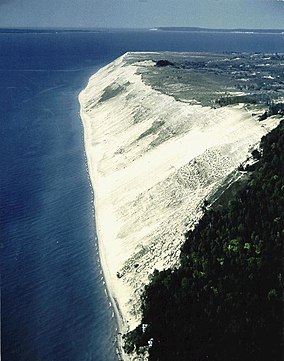Sleeping Bear Dunes National Lakeshore
| Sleeping Bear Dunes National Lakeshore | |
|---|---|
|
IUCN category III (natural monument or feature)
|
|

Aerial view of Sleeping Bear Dunes
|
|
| Location | Leelanau & Benzie counties, Michigan, US |
| Nearest city | Empire, Michigan |
| Coordinates | 44°54′47″N 86°01′13″W / 44.91306°N 86.02028°WCoordinates: 44°54′47″N 86°01′13″W / 44.91306°N 86.02028°W |
| Area | 71,187 acres (288.08 km2) |
| Established | October 21, 1970 |
| Visitors | 1,280,932 (in 2010) |
| Governing body | National Park Service |
| Website | Sleeping Bear Dunes National Lakeshore |
Sleeping Bear Dunes National Lakeshore is a United States National Lakeshore located along the northwest coast of the Lower Peninsula of Michigan in Leelanau and Benzie counties near Empire, Michigan. The park covers a 35-mile-long (56 km) stretch of Lake Michigan's eastern coastline, as well as North and South Manitou islands. This Northern Michigan park was established primarily because of its outstanding natural features, including forests, beaches, dune formations, and ancient glacial phenomena. The lakeshore also contains many cultural features including the 1871 South Manitou Island Lighthouse, three former stations of the Coast Guard (formerly the Life-Saving Service) and an extensive rural historic farm district. In 2011, the area won the title of "The Most Beautiful Place in America" from Good Morning America. In 2014, a section of the park was named the Sleeping Bear Dunes Wilderness by the United States Congress.
The park was authorized on October 21, 1970. The park's creation was highly controversial because it involved the transfer of private property to public. The federal government's stance at the time was that the Great Lakes were the "third coast" and had to be preserved much like Cape Hatteras or Big Sur, which are National Seashores. The residents living in what is now Sleeping Bear Dunes National Lake shore believed they were stewards of the land and did not want it to be overrun by tourists. The government eventually won out in part by supporting the local schools to offset the lost property tax revenue and by adding North Manitou Island to be included in the park.
...
Wikipedia

